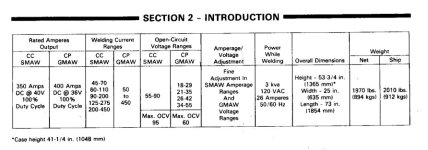Sodo
Elite Member
- Joined
- Apr 21, 2012
- Messages
- 3,296
- Location
- Cascade Mtns of WA state
- Tractor
- Kubota B-series & Mini Excavator
I've seen "duty cycle" mentioned as if its a important consideration for a welder (even for newbies).
I hardly ever have to weld more than a few inches (6" ?) at a time, then I pick up a grinder or do some fitting. Cut stuff, drill holes. Or screw around. But my welder always gets time to cool down.
Yesterday I had a project where I was welding 1 x 1/8" x flatbar doublers on to increase the bending section of my brush fork tines. I decided to fit and tack everything, then go and weld continuous (as possible) until the machine shut down. I am using a Miller Multimatic 200, which has a 20% duty cycle. It's rated for 3/8" thick steel, and I had it set for 3/16" thick. When I bought it they said it will weld at full power for 2 minutes then may require 8 minutes cool down.
At this less-than-full power setting, I welded for 25 minutes straight, only letting go of the trigger for enough time to move to the next weld, and flip the device over once. It never missed a beat. Except I was pretty beat after 147 inches of weld.
I don't know how much longer I could have gone myself. My conclusion is that the duty cycle of my Miller MultiMatic is certainly "sufficient" for my usage. So here's my question, why would someone (non-pro welder) think a 20% duty cycle is insufficient?

I hardly ever have to weld more than a few inches (6" ?) at a time, then I pick up a grinder or do some fitting. Cut stuff, drill holes. Or screw around. But my welder always gets time to cool down.
Yesterday I had a project where I was welding 1 x 1/8" x flatbar doublers on to increase the bending section of my brush fork tines. I decided to fit and tack everything, then go and weld continuous (as possible) until the machine shut down. I am using a Miller Multimatic 200, which has a 20% duty cycle. It's rated for 3/8" thick steel, and I had it set for 3/16" thick. When I bought it they said it will weld at full power for 2 minutes then may require 8 minutes cool down.
At this less-than-full power setting, I welded for 25 minutes straight, only letting go of the trigger for enough time to move to the next weld, and flip the device over once. It never missed a beat. Except I was pretty beat after 147 inches of weld.
I don't know how much longer I could have gone myself. My conclusion is that the duty cycle of my Miller MultiMatic is certainly "sufficient" for my usage. So here's my question, why would someone (non-pro welder) think a 20% duty cycle is insufficient?





